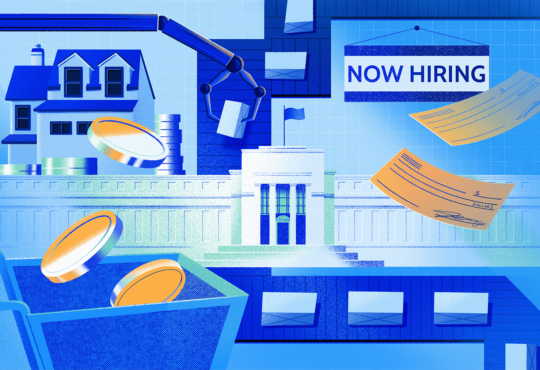
The U.S. unemployment rate has fallen to historically low levels in the past two years, even as the Federal Reserve has ramped up interest rates to tamp down inflation. But record-low unemployment isn’t the case any more in California, the nation’s most populous state, where a steadily climbing unemployment rate might be moving beyond normalization and into treacherous territory.
It is tempting to write off California’s unemployment spike as a localized effect of the tech industry’s rebalancing. Yet, based on at least one economic indicator, the state’s labor outlook is signaling that a nationwide downturn could be in the offing.
California’s unemployment rate increased from 3.83% in August 2022 to 4.5% in May 2023; the national unemployment rate was 3.7% last month. That means California’s three-month moving average rose by 0.63 percentage points relative to its low in the past year, putting the state in or near recession territory, according to the well regarded Sahm rule.
The rule is named for economist Claudia Sahm, whose research found that when the three-month moving average of the national unemployment rate rises by 0.5 percentage points or more, relative to its low during the previous 12 months, it signals a recession.
The Sahm rule can be applied to state economies, too. Although state unemployment data haven’t been tracked as long as national statistics, the Sahm rule generally holds up on a state level, says Julia Pollak, chief economist at the employment site ZipRecruiter. Once the rise in the unemployment rate exceeds the 0.5 percentage-point threshold on a three-month average, it tends to climb by another 1.5 to two percentage points in the coming months, she has found.
Advertisement – Scroll to Continue
“A cycle sets in whereby rising unemployment—either through people staying unemployed longer and finding it harder to find new jobs, or more layoffs—keys people to cut back on their spending, which leads to further reductions in demand for labor,” Pollak says.
Sahm tells Barrron’s that California’s current unemployment rate, and particularly the changes in that rate in the past year, are “blinking yellow.”
California’s rising unemployment has been driven, in part, by the tech sector’s recent stumbles after years of exuberant growth. That weakness has been spilling into other industries. Finance, for example, is seeing a dearth of initial stock offerings and deals. Industries dependent on advertising are also experiencing a contraction.
Advertisement – Scroll to Continue
Four broad employment sectors in California are either shrinking or stagnant, says Chris Tilly, an economist at the University of California, Los Angeles, who focuses on labor trends. They are construction, durable goods, wholesale, and information, which includes media and entertainment jobs. “The big hit is in residential construction,” he says.
Related industries, such as furniture, wood products, architecture, and structural metal also have seen some weakness, he says.
The normalization of interest rates after an era of nearly free money helped quash technology stocks — and the tech sector’s rampant spending. Hybrid work and work-from-home schedules adopted during the Covid pandemic also are darkening the employment picture in California. “This is kind of a remote-work-related, local recession,” Pollak says.
Advertisement – Scroll to Continue
Of the estimated 6.9 million remote workers in the U.S., the largest concentration by far is in California, according to research from Revelio Labs. That has hurt the state’s downtown businesses, including restaurants and retailers, leading to knock-on job cuts far from Silicon Valley.
Beyond rising unemployment, California is grappling a reputation for regulation, high corporate tax rates, and a housing affordability crisis. Conning’s State of the States municipal-credit-quality rankings scored California No. 42 out of 50 this year, 14 spots lower than in 2022. While the growth rate of the state’s gross domestic product per capita was stronger than that of most other states last year, as was its personal income per capita, tax collections lagged dramatically.
As Tilly says, it’s difficult to call California a “bad economy.” The state economy, the largest in the U.S., grew by an annual rate of 0.4% in 2022. With GDP still positive, he says, “California is not in a recession at this point, but it is a risk.”
California isn’t the only state whose unemployment trends crossed the Sahm threshold. Unemployment trends in Oregon, Virginia, and Washington also triggered the Sahm state rule in recent months. But unlike California, the other three states recorded a drop in the unemployment rate in May.
Sahm says she would recommend using a six-month moving average of the unemployment rate to gauge whether a state economy is in or approaching recession, particularly in the case of smaller states. California’s unemployment picture has triggered the Sahm rule based on both a three- and six-month moving average.
Advertisement – Scroll to Continue
The Sahm rule reflects more of a historical pattern than a “law of nature,” Sahm says. But in a handful of cases, state economies have triggered the Sahm rule ahead of a national recession, in effect acting as a bellwether.
“When there is a national recession, typically the state with a disproportionate share of jobs in the industry most affected during that particular recession triggers the rule first,” Pollak says.
Advertisement – Scroll to Continue
Ahead of the 2008-09 recession, for example, Pollak says Florida’s rising unemployment rate triggered the Sahm rule — no surprise, perhaps, given its significant exposure to the subprime housing market, whose problems helped set off the financial crisis of that period.
In California’s case, the state’s current divergence from national trends is the largest since the state unemployment data series began in the 1970s. “In principle, an unemployment rate that has risen notably is worth keeping an eye on because there are cases in which it is the precursor to a larger national recession,” Sahm says.
Additionally, many of the positive labor trends peaked last fall in California, Tilly says. “What that says to me is, California may be a leading indicator for what’s happening elsewhere,” he says. “California looks less like an outlier, and more like a leader in a downturn that could end up in a soft landing or a recession.”
There have been instances in which state economies triggered the rule without a corresponding nationwide recession. Usually, on a state level, the rule tends to correspond with a localized labor downturn or natural disaster. Louisiana and Mississippi, for example, triggered the rule in 2005 with Hurricane Katrina. Texas has also hit the Sahm threshold without any national downturn in the past, due to its ties to the volatile energy industry.
So far, national data don’t mirror California’s economic trends. The national unemployment rate rose in May from April’s record low of 3.4%, but remains historically low. So long as that is the case, Sahm believes the U.S. won’t enter a recession.
Yet, with many economists predicting a recession starting later this year or early in 2024, indicators like California’s unemployment merit more attention nationally. “Where we are headed is unclear, but regardless, we should be ready to help people,” Sahm says.
Write to Megan Leonhardt at [email protected]






